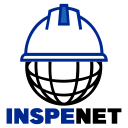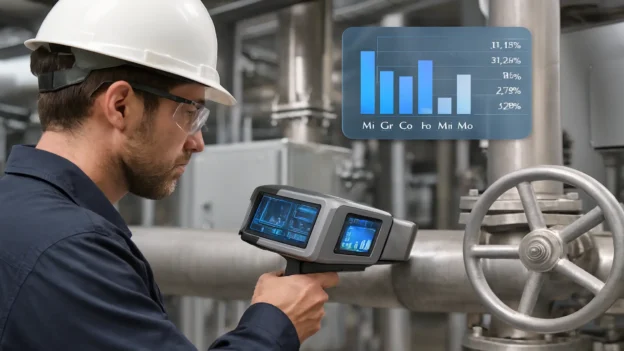The API 578 standard establishes the technical guidelines for material verification in equipment, components, and piping subject to critical operating conditions. Its application allows confirmation that the installed metallic materials comply with the chemical and metallurgical specifications required to ensure mechanical integrity and avoid failures associated with incorrect material selection.
In the current industrial context, the presence of out-of-specification alloys represents a significant risk, as it can cause accelerated degradation, metallurgical incompatibilities, or corrosion failures. The API 578 standard provides a systematic approach for Positive Material Identification (PMI), integrating analytical techniques such as X-ray fluorescence and other non-destructive methods to validate the composition of materials in service or during the manufacturing stage.
The purpose of this article is to explain the technical scope of API 578 and its application in material verification programs, detailing the methods used for the positive identification of alloys, metallurgical control criteria, and practices that ensure chemical conformity and the integrity of metallic materials installed in critical equipment.
Importance of metallurgical control
Metallurgical control ensures the mechanical integrity of equipment operating under high temperatures, elevated pressures, and corrosive environments. Through the application of API 578, it is verified that metallic materials comply with the chemical composition, metallurgical structure, and mechanical properties specified in codes such as ASME, API, or ASTM. This procedure allows the identification of deviations in critical alloys, ensuring metallurgical compatibility and resistance to corrosion, embrittlement, or premature failures.
The analysis includes positive material identification and techniques such as X-ray fluorescence, confirming that the components used in piping, pressure vessels, and critical equipment correspond to the design specifications. This ensures that the materials can withstand corrosive fluids, hydrocarbons with contaminants, or high-temperature environments, maintaining the reliability and operational safety of the facilities.
Material verification and positive identification
Material verification is based on both non-destructive and destructive analytical methods through which the chemical composition of components is validated. Positive Material Identification (PMI) is the main technique and is applied to confirm alloys, detect unauthorized substitutions, and verify compliance with project specifications. PMI using X-ray fluorescence is widely used due to its speed and reliability for surface elemental analysis without altering the component.
Applied technologies and selection criteria
The verification of metallic materials is performed using modern identification techniques that gradually replace traditional methods such as visual inspection or spark testing. These advanced technologies enable more precise, faster, and more reliable analysis of chemical composition and metallurgical properties, ensuring that materials meet design requirements and standards such as API 578.
Among the main technologies used are X-ray fluorescence (XRF), Laser-Induced Breakdown Spectroscopy (LIBS), and Optical Emission Spectroscopy (OES), each selected according to the type of material, required level of detail, and the criticality of the component being inspected.
X-Ray Fluorescence (XRF)
Portable X-ray fluorescence allows rapid identification of ferrous and non-ferrous alloys by detecting the fluorescent radiation emitted by the metal’s atoms when excited by X-rays.
This technique provides immediate results with high precision, reaching tolerances of up to 0.1%, and is widely applied in metal recycling, alloy verification, and material classification, ensuring compliance with industrial specifications and preventing contamination by undesirable elements. Due to its speed and efficiency, XRF is mainly used in field inspections and in situations where rapid decision-making is required.
Laser-Induced Breakdown Spectroscopy (LIBS)
Laser-Induced Breakdown Spectroscopy (LIBS) generates a high-temperature plasma through the incidence of a laser beam on the metal surface. The light emitted by the plasma is analyzed to determine the elemental composition of the material. LIBS stands out for its speed and portability, allowing in-situ testing with precision in the range of 1 to 2%.
This technology is applied in sectors such as construction, recycling, and automotive manufacturing, where rapid analysis of metallic composition is required without transporting samples to a laboratory.
Optical Emission Spectroscopy (OES)
Optical Emission Spectroscopy (OES) excites metallic atoms through electrical energy, causing the emission of light whose wavelength and intensity are analyzed to determine the material’s composition. OES provides high precision, reaching 0.01% in the detection of critical elements such as carbon, silicon, and molybdenum in steel alloys. Its use is essential in steel production, foundries, automotive manufacturing, and the aerospace industry, ensuring that materials meet the required standards of strength, hardness, and mechanical properties.
API 578 establishes technical criteria for selecting the most appropriate technique based on equipment criticality and material type, determining the inspection scope within a material verification program. This approach allows prioritization of resources toward components with higher operational risk, ensuring that the mechanical and metallurgical integrity of materials remains under control, preventing embrittlement, premature failures, or metallurgical incompatibilities that could compromise safety and operational continuity.
Material verification program
A material verification program in accordance with API 578 integrates documented procedures, acceptance criteria, inspection levels, and traceability records. This program maintains metallurgical control during the fabrication, assembly, and operation of facilities, allowing organizations to detect deviations early and ensure that installed metallic materials meet design requirements. Its implementation contributes to operational reliability, industrial safety, and regulatory compliance in industries such as oil, gas, petrochemical, and power generation.
Heat exchanger verification program
To illustrate the implementation of a material verification program according to API 578, a heat exchanger operating with corrosive fluids and high temperatures can be considered. The verification workflow is organized into stages:
- Stage 1: First, positive material identification (PMI) is performed using X-ray fluorescence (XRF) to determine the elemental composition of alloy pipes and plates, confirming the presence of chromium, nickel, and other critical elements.
- Stage 2: Next, optical emission spectroscopy (OES) is applied to representative samples to verify light elements and metallurgical properties that may affect mechanical strength and compatibility with the process fluid.
- Stage 3: The results obtained are recorded in the metallurgical control program database, assigning conformity codes and criticality alerts for each component. If deviations from specifications are detected, corrective actions such as pipe replacement, surface treatment, or modification of operating conditions are scheduled.
This workflow ensures that the information collected not only documents material conformity but also enables the development of evidence-based predictive maintenance plans, improves scheduled shutdown planning, and optimizes metallurgical risk management. Visualizing this process in a flow diagram helps understand the sequence of techniques, assignment of responsibilities, and recording of results, reinforcing the technical coherence of the material verification program.
Final reflection: API 578 in metallurgical risk management
The application of API 578 has become an indispensable tool for ensuring that materials installed in critical equipment comply with the metallurgical and chemical requirements established in design codes. Its systematic approach to positive material identification allows the precise detection of deviations that may compromise mechanical integrity, accelerate corrosion mechanisms, or generate metallurgical incompatibilities.
The integration of analytical technologies such as XRF, LIBS, and OES within a structured verification program provides the industry with a highly reliable option to ensure that installed materials respond appropriately to operating conditions. This standard strengthens metallurgical risk management and directly contributes to operational continuity, industrial safety, and the prevention of premature failures in high-criticality sectors such as oil, gas, and power generation.
Conclusions
The implementation of API 578 for material verification and metallurgical control ensures that metallic components comply with the chemical and mechanical specifications established by industrial codes such as ASME and API. The use of modern technologies such as X-ray fluorescence (XRF), Laser-Induced Breakdown Spectroscopy (LIBS), and Optical Emission Spectroscopy (OES) enables precise determination of alloy elemental composition, ensuring material integrity and preventing critical failures, embrittlement, or accelerated corrosion in demanding service conditions.
A structured material verification program facilitates the identification of critical components and optimizes resource allocation in metallurgical inspections. This practice ensures operational reliability, process safety, and continuity of operations, while supporting compliance with international standards and strengthening the quality of metallurgical control in industrial facilities.
References
- American Petroleum Institute. (2019). API 578: Material verification program for new and existing metallic materials. API.
- American Society of Mechanical Engineers. (2021). ASME Boiler and Pressure Vessel Code. ASME.
- Roberge, P. R. (2012). Corrosion engineering: Principles and practice (2nd ed.). McGraw-Hill.
- Callister, W. D., & Rethwisch, D. G. (2020). Materials science and engineering: An introduction (10th ed.). Wiley.


